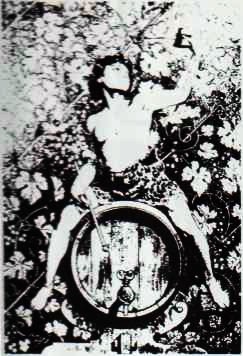Le radici del Cabernet sono diverse, si perdono nella notte dei tempi, alcuni storici sostengono che sono da ricercarsi in Spagna, verso il versante dei Pirenei e poi questa vite fu importata in Francia, a Bordeaux, grazie al passaggio di alcuni pellegrini, tanto che il Cabernet fu impiantato nella Loira, considerata oggi la zona ideale per la sua coltivazione, dato che preferisce i climi freddi.
Questo vitigno vitigno viene reso celebre e diffuso nel resto della Francia nel XVII secolo dai nobili francesi,c ome Hector de Brane e Armand d’Armailhacq.
Il Cabernet nasce in modo incisivo nella Gironda, a Saint-Emilion, posto che ancora oggi rappresenta il top della qualità del Vitigno.
Su forti raccomandazioni del Cardinale Richilieu, l’abate Breton dell’Abbazia di Saint-Nicolas de Borgueil lo rende famoso nella zona della Loira.
In seguito nel corso del XVIII secolo, viene poi introdotto in Friuli, Veneto e Trentino, regioni nelle quali viene attualmente prodotto.
Il Cabernet prodotto in Italia è assai simile a quello che viene coltivato nelle valli della Loira.
Altre fonti storiche affermano che questo vitigno deriva dalla Vitis Biturica, di cui parla Plinio il Vecchio nella sua opera de naturalis Historia e che giunse in Italia dal porto di Durazzo( In Albania), in seguito fu trapiantata in Francia dai soldati romani ed ivi impiantata .
Alcune fonti sostengono in modo vigoroso che in Francia l’Editto di Domiziano 98 D.C. con l’imperatore Probo fu abolito (fonte Antonio Dacomo cita un Imperatore romano, vissuto nel III secolo D.C. che in modo determinante ripristinò la coltura della vite in modo intenso.
Grande figura sulla accentuazione e soprattutto diffusione della pianta della vite in Europa è l’imperatore Marco Aurelio Probo , da non confondere con il più famoso Marco Aurelio Antonino Augusto,altro grandissimo imperatore,intellettuale e soprattutto filosofo che vissuto cento anni prima.

Questa figura imperiale e carismatica della storia del vino di Probo viene fuori in tutti i luoghi dove Roma ha governato la vite fu impiantata dalle fredde terre del Vallo di Adriano, alla calda penisola Iberica, alla Gallia intera alle gelide terre germaniche fino alla Pannonia e alla Mesia costeggiando il fiume Danubio, ovviamente anche l’Italia, questo Imperatore lasciò scolpito il suo nome in tutti i vignaioli d’Europa e del Mondo.
La sua lungimiranza fu quella di abolire l’editto di Domiziano che promosse la coltivazione della vite in tutti i territori dell’Impero Romano dove era possibile che cresceva, due secoli prima L’Imperatore Domiziano aveva proibito la coltivazione e ordinato l’espianto della vite in tutti i territori al di là delle Alpi, nell’intento di reintrodurre frumento e graminacee come difesa in vista di possibili carestie.
L’ Imperatore Probo famoso nell’Historia Augusta come colui che garantì ai Galli, agli Ispanici e ai Britanni di impiantare vigneti e produrre vini, ed egli stesso scelse e piantò le viti con le proprie mani sul Monte Alma nei pressi di Sirmio in Illiria .
Troviamo il busto di marmo del grande Imperatore romano lungo la Mosella eretto dai viticoltori locali come una devozione per aver dato lustro a questa zona con i vigneti che lui incoraggiò facendo di Augusta Treverorum la capitale della viticoltura tedesca, senza la sua impronta nell’incentivare i vigneti le valli del Reno sarebbero state squallide valli del Reno.
Studi recenti di genetica hanno provato tramite analisi del D.N.A. che le viti della Borgogna discendono tutte da un antenato comune , un vitigno che stato portato da Probo dalla Dalmazia, e che subì varie mescolanze di materiale genetico.
Questo Imperatore romano incentivò le sue legioni a impiantare nelle floride colline della Gallia e della Pannonia le vigne nei momenti di pace, così faceva anche Annibale, per preservare le sue truppe dal pericoloso ozio, le aveva costrette a impiantare le vaste piantagioni di ulivi lungo la costa dell’Africa.
Questo padre fondatore della moderna viticoltura il sublime e grande imperatore Romano Marcus Aurelius Probus nasce e muore a Sirmio, l’odierna Sremska Mitrovica, non lontano da Belgrado, nasce il 9 agosto 232 e viene ucciso dai soldati congiurati, insofferenti per i ritmi di lavoro che dovevano subire.
In Italia non si sa il preciso momento in cui questo vino arrivò, alcune fonti sostengono che arrivò nel 1820 ad opera del conte Manfredo di Sambuy, che iniziò a coltivarle provandole o sperimentandole nelle sue tenute di Marengo(Al) e nel 1867 si ha notizia del Cabernet a Verzuolo , nel Cuneese, questo vitigno faceva parte della collezione ampelografica del conte Giuseppe di Rovasenda.
Grazie a questo Imperatore che impiantò in tutta Europa vini, in seguito nacquero vini sublimi come lo Champagne e il Riesling, grazie anche al paziente lavoro svolto dagli enologi).
Nel 1877, il cabernet, questo vitigno era coltivato presso la Reale scuola di Viticoltura ed Enologia di Conegliano, mentre nel Trentino su volere dell’Imperatore Francesco Giuseppe, essendo la zona più a sud dell’Impero Austro-Ungarico.
Il vino Cabernet fece ufficialmente la sua comparsa in Friuli nell’anno 1883,nella esposizione tenuta a Udine nel 1883,dove emerse come il Cabernet si impose come ottimo vino da pasto e fra le migliori qualità importate dal Bordolese(zona di Bordeaux).
Fu nella mostra organizzata a Cividale nel 1896 che la giuria, incaricata di esaminare i numerosi vini presentati all’esposizione, premiò con medaglia d’oro, il Cabernet dell’azienda Brazzà, che il pubblico abituato ai vini dell’epoca, sempre più in continuo miglioramento .

Un altro ottimo produttore in Friuli di Cabernet i conti Perusini Antonini e la tenuta di Rocca Bernarda a Ipplis nell’Udinese.
Possiamo affermare che in Friuli il vino ha sempre aiutato i Friulani nei momenti più difficili nella Storia, come durante l’assedio dell’Abbazia di Rosazzo portato dagli Ungari nel 1431, o come quando il duca di Brunswick in guerra con Venezia nel 1509 mise a ferro e fuoco questi territori sotto il dominio della Repubblica di San Marco. Cividale del Friuli ha sempre rivestito un ruolo fondamentale per la produzione del vino.
I legionari di Roma a Forum Julii (l’odierna Cividale del Friuli fondata da Giulio Cesare) introdussero la vite, I Longobardi oltre a farne la prima capitale del regno Longobardo, divenne un centro importante per lo smistamento dei vini verso il Norico e la Pannonia.
Il vino era talmente in considerazione dai Longobardi, che ancora oggi si può ammirare la Vigna del Signore in un pregevole stucco conservato nel tempietto di Santa Maria in Valle, eretto nell’ottavo secolo D.C. Cividale è anche sede di una rassegna primaverile dei vini della zona,che si effettua a ricordo di un’antica mostra di vini bianchi e rossi che si sono tenuti nel 1888 e nell’aprile del 1896 venne tenuto a Cividale una fiera di largo consumo dei vini da pasto.
Il vino in Friuli-Venezia-Giulia è storia, filosofia, sociologia, dal punto di vista intellettuale, ma rappresenta una forma di aggregazione sociale che abbatte ogni steccato sociale, ogni pregiudizio etnico e soprattutto accentua la meditazione spirituale fino a raggiungere una dimensione divina.
Non bisogna dimenticare che molti accordi e trattati internazionali sono stati raggiunti degustando e sorseggiando un buon bicchiere di vino da qui si evincono non solo le proprietà benefiche del vino, ma la sua funzione determinante per armonizzare le relazioni sociali.
Il motto : vino veritas , vale sempre.

Autore: Principe Don Roberto d’Amato, Dottore in Giurisprudenza, Dottore in Scienze politiche ed economiche e sociali, Dottore in storia.





